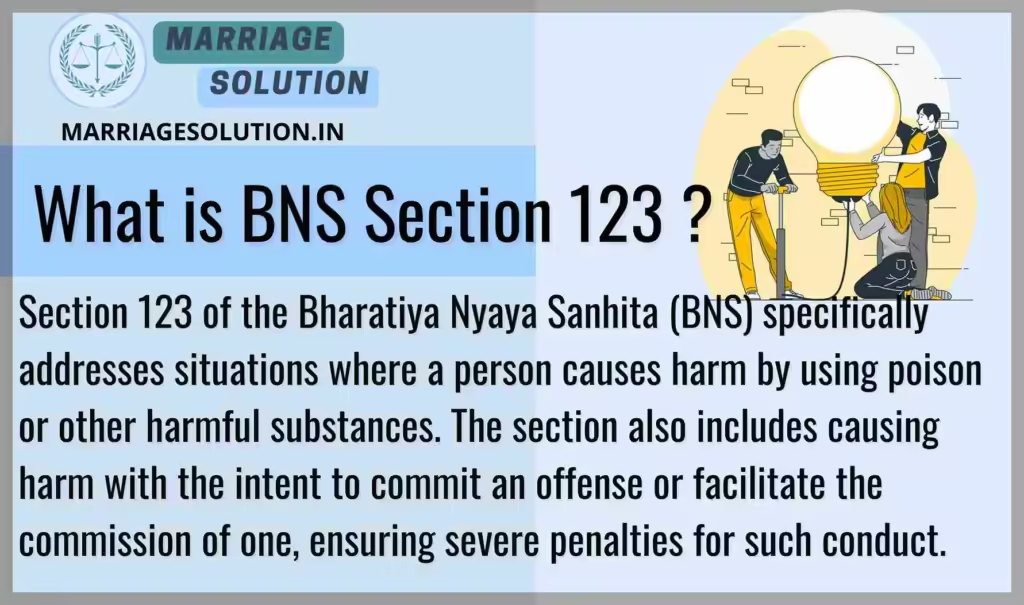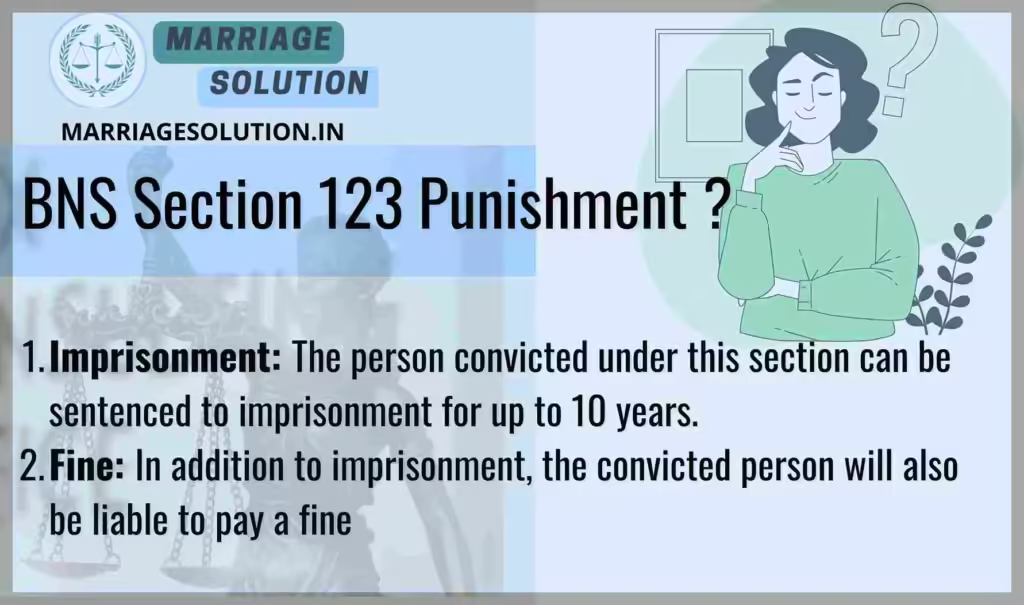Introduction of Section 123 BNS
BNS Section 123, deals with crimes involving poison, drugs, or other harmful substances. Whether it is an attempt to injure, intoxicate, or commit another crime, this law provides strict punishment. Replacing IPC Section 328, it modernizes the law by keeping punishments severe (up to 10 years imprisonment) and ensuring that such offences are treated as non-bailable and cognizable. This article explains Section 123 in simple language, with punishments, examples, and comparison with IPC.
The Bharatiya Nyaya Sanhita (BNS) Section 123 replaces the old Indian Penal Code (IPC) Section 328.
- Introduction of Section 123 BNS
- What is BNS Section 123 ?
- Bare Act – BNS Section 123
- Why Section 123 is Important
- Section 123 BNS Overview
- BNS 123 Punishment
- BNS 123 bailable or not ?
- Bharatiya Nyaya Sanhita Section 123
- Comparison Table – BNS Section 123 vs IPC Section 328
- BNS Section 123 FAQs
- Conclusion
- Need Legal Support?
What is BNS Section 123 ?
Section 123 of the Bharatiya Nyaya Sanhita (BNS) specifically addresses situations where a person causes harm by using poison or other harmful substances. The section also includes causing harm with the intent to commit an offense or facilitate the commission of one, ensuring severe penalties for such conduct.

BNS Act – BNS Section 123
“Whoever administers to, or causes to be taken by, any person any poison, intoxicating, stupefying, or unwholesome drug or other substance, with intent to cause hurt or to commit or facilitate the commission of an offence, shall be punished with imprisonment of either description for a term which may extend to ten years, and shall also be liable to fine.”
This section is about crimes where someone uses poison or other harmful substances to hurt another person. It does not matter whether the harm is direct (like poisoning food) or indirect (like giving drug-laced drinks to make a person unconscious).
The law says a person is guilty if:
- They intentionally administer poison, drugs, or harmful things to someone, OR
- They make someone consume such substances, even without their knowledge.
The purpose of doing this can be:
- To cause hurt (physical or mental harm), or
- To commit another crime (like robbery, kidnapping, or sexual assault), or
- To make it easier to commit a crime (for example, making someone unconscious before stealing).
Key Elements of Section 123
- Use of poison or harmful substances → Includes poison, intoxicants, stupefying drugs, acids, or any other harmful substance.
- Intention or knowledge → The person must have intended to cause harm or at least known that their act was likely to cause harm.
- Facilitating a crime → Even if the harm is not the main goal, using poison to make another crime easier is still punishable.
- Punishment → Up to 10 years imprisonment + fine.
- Nature of offence → Cognizable (police can arrest without warrant) and non-bailable (bail is not easily granted).
- Trial → Heard in the Court of Session because of the seriousness of the offence.
Examples to Understand BNS 123
- Example 1 – Poison in Food: A mixes poison in B’s food to weaken him before committing theft. → Punishable under Section 123.
- Example 2 – Drugged Drink: A gives B a drink laced with sleeping pills to kidnap him later. → Punishable under Section 123.
- Example 3 – Harm for Revenge: A knowingly gives a harmful drug to B just to cause sickness. → Punishable under Section 123.
Why Section 123 is Important
- Protects society from hidden and dangerous crimes like poisoning, drugging, and intoxication.
- Recognizes that even if the harm is not immediate, the use of poison or drugs for crimes is a serious threat.
- Ensures strict punishment so that offenders cannot misuse dangerous substances.
Section 123 BNS Overview
BNS Section 123 of the Bharatiya Nyaya Sanhita (BNS) addresses the offense of causing hurt by administering poison or other harmful substances. It covers situations where a person knowingly or intentionally uses such substances to cause harm or to commit another crime. The section provides for strict punishment, including up to 10 years of imprisonment and fines, to prevent the misuse of dangerous substances.
BNS Section 123: 10 Key Points
- Poison and Harmful Substances: The section covers acts where poison or harmful drugs are used to cause hurt or assist in committing a crime.
- Intent to Harm: The offender must have a clear intent to cause harm or to facilitate the commission of an offense by using dangerous substances.
- Knowledge of Harm: If the person knows that their action of administering the substance could cause harm, they are still liable, even if causing harm wasn’t their main goal.
- Severe Penalties: Offenders can face up to 10 years in prison and a fine. This is to ensure that anyone who tries to harm others using poison or dangerous substances faces serious legal consequences.
- Non-Bailable Offense: BNS Section 123 is non-bailable, meaning that securing bail for the accused is not easy due to the seriousness of the crime.
- Cognizable Crime: The police have the authority to arrest the accused without a warrant since the offense is considered serious.
- Intention to Commit Other Crimes: The section also includes instances where poison or harmful substances are used not just to hurt but to facilitate or commit other crimes.
- Non-Compoundable: The offense is non-compoundable, meaning it cannot be settled privately between the parties. It must go through the judicial system.
- Court of Session: Cases under this section are tried in the Court of Session, reflecting the seriousness of the offense.
- Focus on Protection: The law under this section aims to protect people from the malicious use of poisons or dangerous substances in any situation where harm is intended or known to be likely.
BNS Section 123: 2 Examples
- Example 1: A person slips a poisonous substance into another person’s food with the intention of weakening them so they can rob the victim later. This would fall under BNS Section 123, as the use of poison was intended to facilitate a crime (robbery).
- Example 2: A person knowingly administers a harmful drug to another person at a party, causing them to become intoxicated and unable to protect themselves. The act is carried out with the knowledge that it will likely cause harm, even though the direct intent may not have been to hurt the individual. This would still be covered under BNS Section 123.
BNS 123 Punishment
Imprisonment: The person convicted under this section can be sentenced to imprisonment for up to 10 years.
Fine: In addition to imprisonment, the convicted person will also be liable to pay a fine

BNS 123 bailable or not ?
BNS Section 123 is a non-bailable offense, meaning the accused cannot claim bail as a matter of right, and the court has discretion to grant or deny bail.
Comparison Table – BNS Section 123 vs IPC Section 328
| Law | Offense | Punishment | Cognizability | Bailability | Trial By |
|---|---|---|---|---|---|
| BNS 123 | Causing hurt by poison or harmful substances with intent to commit an offence | Imprisonment up to 10 years and fine | Cognizable | Non-bailable | Court of Session |
| IPC 328 | Causing hurt by poison, stupefying, intoxicating or unwholesome substances with intent to commit an offence | Imprisonment up to 10 years and fine | Cognizable | Non-bailable | Court of Session |
BNS Section 123 FAQs
What does BNS Section 123 cover?
BNS Section 123 covers situations where harm is caused by administering poison or harmful substances, especially when done with the intent to commit or facilitate an offense.
What is the maximum punishment under Section 123?
The maximum punishment under this section is imprisonment for 10 years along with a fine.
Is this offense bailable?
No, offenses under BNS Section 123 are non-bailable, meaning the accused does not have an automatic right to bail.
What type of offense is this under BNS Section 123?
The offense is cognizable, meaning the police can arrest the accused without a warrant.
Which court handles trials for this offense?
Cases under BNS Section 123 are tried by the Court of Session.
Is the offense compoundable?
No, the offense is non-compoundable, which means it cannot be settled out of court by the involved parties.
Conclusion
BNS Section 123 is one of the strictest provisions in Indian criminal law against crimes involving poison or harmful substances. Whether the intent is to directly harm someone or to facilitate another crime, offenders face up to 10 years imprisonment and heavy fines. By retaining the core of IPC Section 328 while updating its structure under BNS 2023, the law ensures clarity and strong deterrence. This section plays a crucial role in protecting society from malicious use of poison, drugs, and intoxicants
Need Legal Support?
If you’re facing court proceedings, marriage-related issues, or any legal matter, our team at Marriage Solution – Lawyer Help is ready to guide you. Just complete our easy online enquiry form, and we’ll connect you with the right legal assistance tailored to your needs.
Finished with BNS 123 ? Continue exploring the next provisions of the Bharatiya Nyaya Sanhita (BNS), 2023. Each section includes explanations, examples, and plain-language breakdowns for easy understanding.
- BNS Section 124 : Voluntarily causing grievous hurt by use of acid, etc .
- https://marriagesolution.in/bns_section/bns-section-124/
- 125 BNS :Act endangering life or personal safety of others.
- https://marriagesolution.in/bns_section/125-bns/
- BNS 126 : Wrongful restraint .
- https://marriagesolution.in/bns_section/bns-126/
- 127 BNS : Wrongful confinement .
- https://marriagesolution.in/bns_section/127-bns/
- BNS Section 128 : Force .
- https://marriagesolution.in/bns_section/bns-section-128/
Full IPC Section List: https://marriagesolution.in/ipc-section-list
All Indian Law & Blogs: https://marriagesolution.in/indian-law/
Full BNSS Section List: https://marriagesolution.in/bnss_section-list
